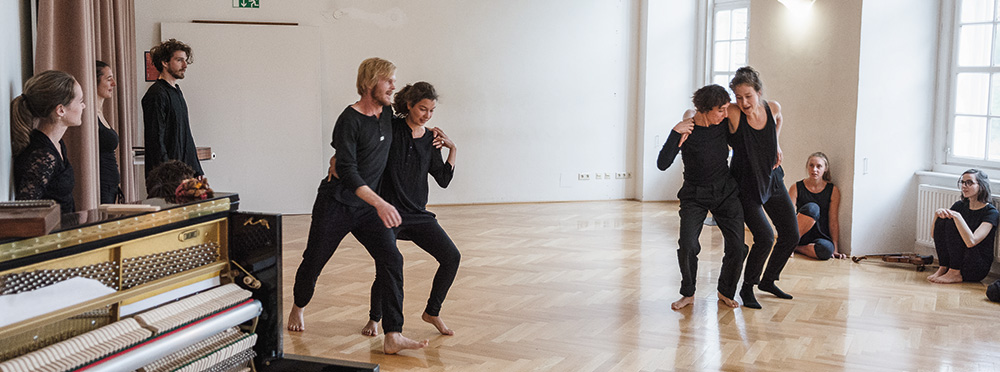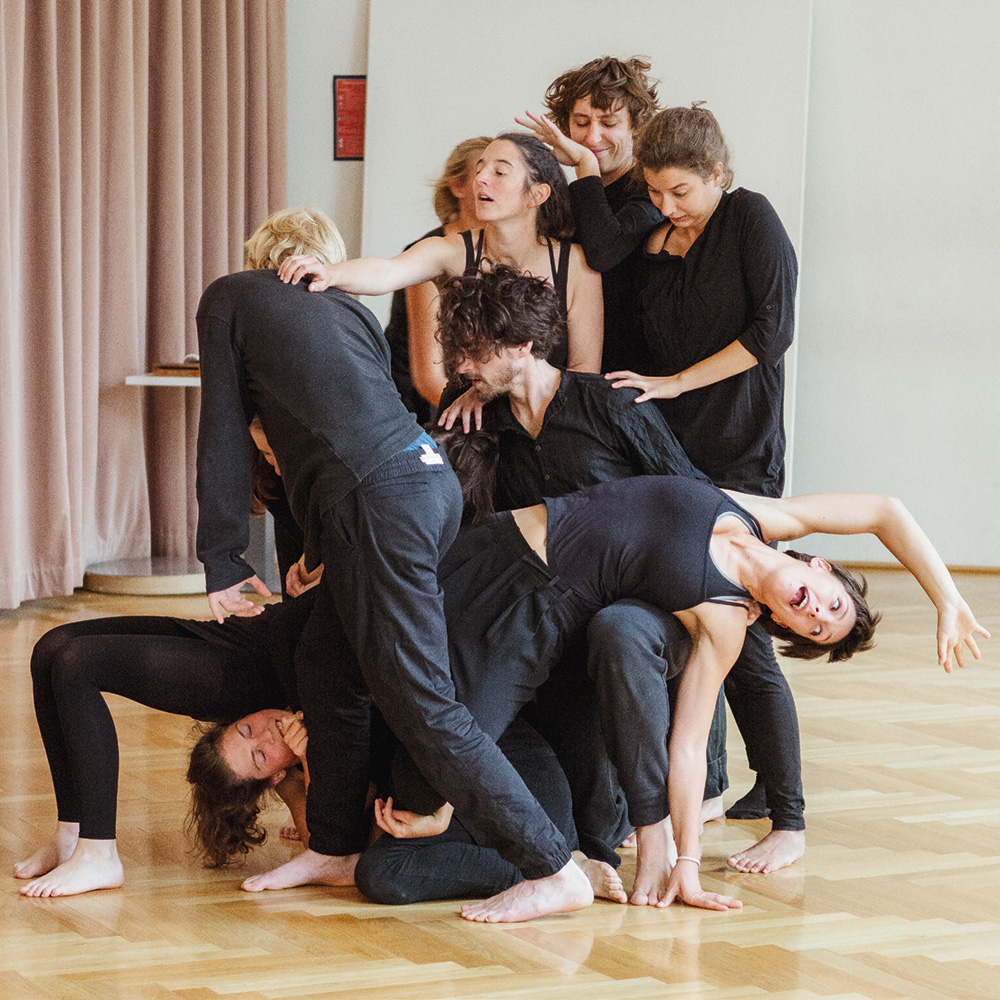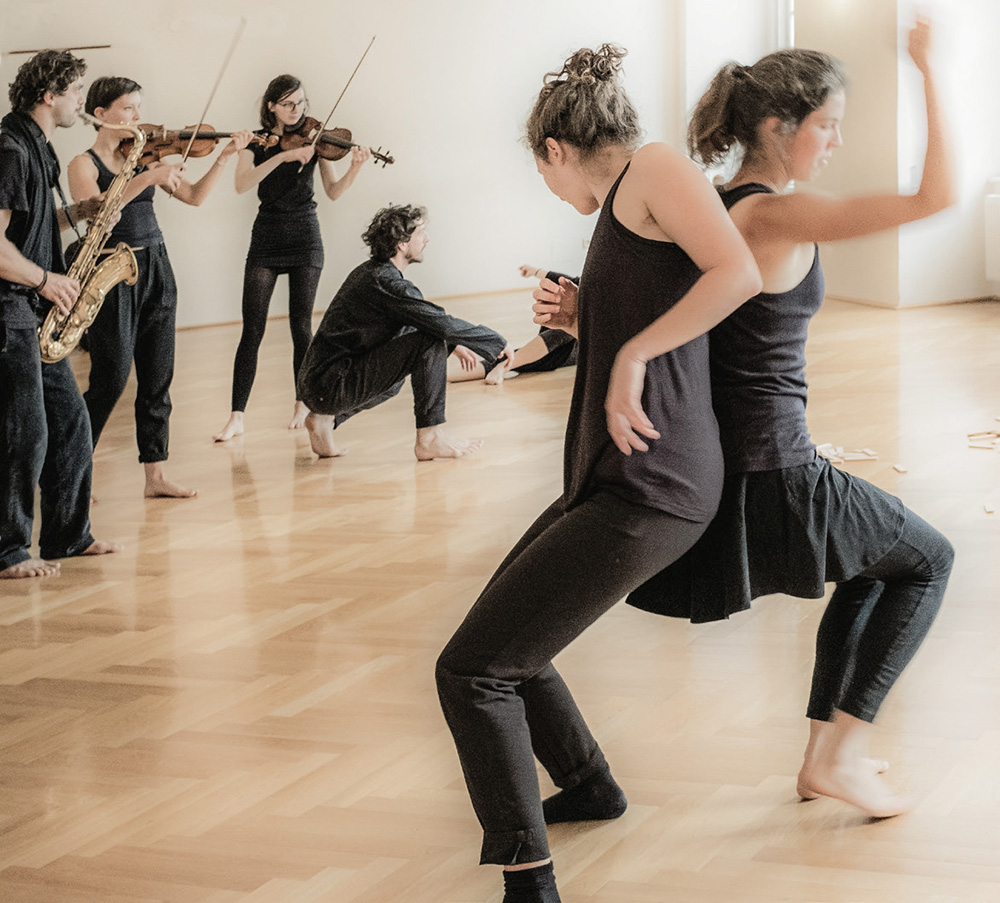„Performing the piece now feels like we are chasing meaning but then constantly undermining it from another direction, or from another form; so if we are making music, then it’s undermined by the dance, or the dance is undermined by the words.“
Jonathan Burrows, 2005

What this quotation so fittingly describes is a process of searching for meaning in one’s artistic pursuits, a process that is at the same time always characterised by sensory impressions. These in turn beget aesthetically relevant decisions and actions. The diverse kinaesthetic, visual, auditory, tactile, and haptic impressions that affect the individual involved in an improvisation that employs the media of the body, music, imagery, and language find expression as the motors of their own new actions. In the Rhythmics degree programme1, this sensory approach by way of art-directed methods enjoys a central place in artistic and pedagogical practice. The kind of improvisation at issue here differs from the realisation of a thoroughly preconceived piece in that it derives its developmental energy from momentary experience, a process that is complex on many levels (psychoacoustic, neurobiological, psycho-motoric, and social). Improvisation plays a both qualitatively and quantitatively important role in the Rhythmics degree programme. Students spend eight semesters training on the piano and in instrumental improvisation as well as in “Accompaniment of Motion”2 on their respective first instruments, and they devote equally intense study to improvisatory motion and interdisciplinary improvisation in their main subject of Rhythmics / Music and Movement. The improvisatory processes that take place as part of this coursework are often initiated by suggestions for aesthetic transformation. “Show what you’re hearing” was the summons of Emile Jaques-Dalcrozes3 with regard to translation from one expressive medium into another—in this case, from music into motion. Such aesthetic transformation is a constitutive phenomenon of Rhythmics as an interdisciplinary or “hybrid” programme of study4 with its pillars of music and movement. In the various creative subjects within the main artistic subject of Rhythmics, students deal constantly with reception and production as well as with cognition and perception in and through music, body/movement/dance, image/object, and language.5

What exactly happens during the aesthetic transformative process of “Show what you’re hearing”? Is it about getting to the bottom of a sound or a musical motif, exploring its “taste” by dancing? And how, as part of this process, can dimensions of sound such as tonal density, pitch, and tone colour be experienced in movement as a nuance in one’s muscle tone or perhaps as one’s orientation within a space?
Or does the process of transformation in fact serve the purpose of researching material for an artistic concept? What role does dialogue play with itself, with an object, with an opposite, or with a group in this respect? Does the search for meaning, described as “chasing meaning” in the opening quotation by Burrow, fundamentally form a common golden thread in aesthetic acts?
Aesthetic transformation is characterised by highly individual ways of perceiving and being affected by the expressive media6 of music, the human body, imagery, and language. The attempt to affect an analogue portrayal of the aesthetic statement made by one medium (the body) via a second, different medium (music) is of great interest as an object of research, since these expressive media are beholden to laws both similar and different. Which is to say: How can the body (as a phenomenon anchored in space) be translated into music (which is a phenomenon that exists only within temporal structures)? How can events situated in space, time, force, and form be expressed musically as well as via movement? Even if music invariably adheres to its own rules when a composition is written, this type of approach will nonetheless allow music to access new potentials. The appropriation of characteristics from another medium such as a visual image—characteristics such as three-dimensionality, proximity and distance, colours, or similar—encourages experimentation with new time sequences, nuances in tone colour, harmonic progressions, and/or formal constructions.

Analogue to the effects of the expressive media sketched out above, the Rhythmics programme also pays attention to the personal feelings and modes of both perception and action by individual people themselves. And precisely herein lies the potential of Rhythmics-specific creative work: students are called upon to develop their own ideas and conceptions in a mode that is not reproductive but rather creative. One’s subjective positioning vis-à-vis an artistic idea in combination with simultaneous reflective distance paves the way to the development of a personal artwork and, what’s more, to a personal concept of art—as well as to the development of an individual stance in one’s general artistic and pedagogical practice.
Authors: Hanne Pilgrim, Jutta Goldgruber-Galler, Nora Schnabl, Herta Hirmke-Toth
Literature:
- Brandstätter, Ursula (2008). Grundfragen der Ästhetik. Vienna: Böhlau.
- Brandstätter, Ursula (2013). Erkenntnis durch Kunst. Vienna: Böhlau.
- Burrow, Jonathan (2005) quoted by Julia Ostwald in her lecture “Tanz – Stimme – Notation” (at the Symposium “Notation: Imagination und Übersetzung”, Vienna 2018)
- Jaques-Dalcroze, Émile (1921/1994). Rhythmus, Musik und Erziehung. Seelze: Kallmeyer.
- Pötschke, Margot (1960). Zeige, was du hörst. Teil 1. Frankfurt: Wilhelm Hansen.
1 The complete name in the curriculum is “Music and Movement Education / Rhythmics”; in the interest of readability, it is abbreviated here as “Rhythmics”.
2 This is a specific subject central to the Rhythmics programme that deals with improvising nuanced instrumental accompaniments of movement and dance.
3 This Vienna-born composer and music educator established the method of Rhythmics (at first called Rhythmic Gymnastics) around the turn of the 19th to the 20th century. Jaques-Dalcroze sought to allow music to be seen and experienced via the body within a space. He assumed that it was essential to precede aesthetic and artistic training with the creation of a physical awareness of the forces working within human beings and the development of an ability to employ these forces in a deliberate manner. Dalcroze is viewed as a pivotal figure in modern dance and in both elementary and more “complex” music education.
4 The special feature of the Rhythmics programme is that, in its teaching, the fields of music and motion are dealt with, practiced, and explored not in parallel, but much rather in constant interplay with each another as part of the main artistic subject of Rhythmics; there are of course also numerous courses that serve to cover purely musical or dance-related training within the curriculum module Praxis von Musik und Bewegung [The Practice of Music and Movement].
5 A special and essential feature here is that the creative subjects are taught primarily in group settings, entailing special potentials for creative and interactive processes.
6 In Grundfragen der Ästhetik (2008) and Erkenntnis durch Kunst (2013), Ursula Brandstätter describes the ways in which the expressive forms of music, image, language, and the body are perceived by and affect human beings, and she also develops hypotheses with regard to aesthetic transformation’s epistemological potential.

